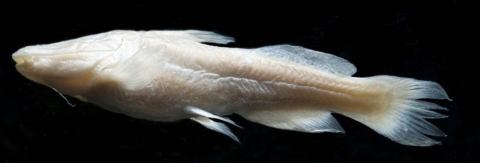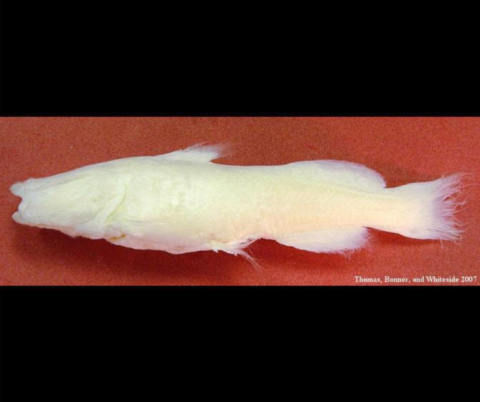The U.S. Fish and Wildlife Service today announced a proposal to list the toothless blindcat and widemouth blindcat, two cave-dwelling catfish species from the San Antonio segment of the Edwards Aquifer in Bexar County, Texas, as endangered under the Endangered Species Act (ESA).
After reviewing the best available science, the Service finds that both of the “blindcats” are in danger of extinction throughout their range due to mortality from uptake by groundwater wells.
The blindcats were first discovered in the early 1900s from fish ejected from groundwater wells. They are among the smallest catfishes in Texas, measuring no more than a couple of inches. Like other cave-adapted animals, they lack pigment and developed eyes. These fishes inhabit a very deep and little studied region of the aquifer that is inaccessible to humans.
Given the great depth of their habitat, neither species survives ejection from groundwater wells tapping deep portions of the Edwards Aquifer. The widemouth blindcat was last collected from a well in 1984, while the toothless blindcat has been collected in small numbers from a single well as recently as 2022.
“The toothless and widemouth blindcats are among the rarest fish species in the world and are found at the greatest subterranean depths known for cavefish, at over 1,000 feet below the City of San Antonio in the Edwards Aquifer” said Michael Warriner, Supervisory Fish and Wildlife Biologist for the Austin Ecological Services Field Office. “While the great depth of their habitat protects them from many human-caused threats, thousands of these fishes were likely lost over the last one hundred or more years as groundwater pumping activity increased across Bexar County.”
While groundwater pumping has resulted in direct mortality of the blindcats, groundwater quantity and quality in areas of the aquifer that supports habitat for these fishes has not experienced substantial change from historical conditions. Therefore, the Service has determined that designation of critical habitat is not prudent.
The San Antonio segment of the Edwards Aquifer supports a wide array of aquatic species, including seven species listed under the ESA: the fountain darter, Texas blind salamander, San Marcos salamander, Texas wild-rice, Comal Springs riffle beetle, Comal Springs dryopid beetle and Peck's Cave amphipod. These species inhabit the Comal and San Marcos Springs Systems of central Texas and derive their flow from the Edwards Aquifer.
Management and conservation of Edwards Aquifer groundwater resources in the San Antonio segment is led by the Edwards Aquifer Authority, one of the permittees of the Edwards Aquifer Habitat Conservation Plan (EAHCP) completed with the Service in 2013. The EAHCP provides measures to minimize and mitigate take of the seven listed species at Comal and San Marcos Springs. As part of these measures, the EAHCP has committed to maintaining sufficient flows at those spring systems to sustain listed species during a reoccurrence of prolonged drought conditions.
“We recognize that water resources are incredibly important for local communities, landowners, businesses, municipalities and visitors,” said Karen Myers, Field Supervisor at the Austin Ecological Services Field Office. “We look forward to continuing to work collaboratively with the Edwards Aquifer Authority and other local organizations to conserve and protect the Edwards Aquifer for the benefit of people and wildlife.”
The Service is committed to collaborative conservation, transparency, and ensuring that ESA findings are science driven. The Service worked with diverse stakeholders to gather the best available science on these species and collaborate on their conservation.
Comments are invited on the proposed rule to list these species as endangered, which appears in the Federal Register on Aug. 22, 2023. Comments on the proposal may be submitted through Oct. 23, 2023 by one the following methods:
Electronically: Go to the Federal eRulemaking Portal: http://www.regulations.gov. In the Search box, enter the docket number for this rulemaking FWS-R2-ES-2023-0069. For best results, do not copy and paste either number; instead, type the docket number into the Search box using hyphens. Then, click on the Search button. On the resulting page, in the panel on the left side of the screen, under the Document Type heading, check the Proposed Rule box to locate this document. You may submit a comment by clicking on “Comment.”
By hard copy: Submit by U.S. mail to: Public Comments Processing, Attn: FWS-R2-ES-2023-0069, U.S. Fish and Wildlife Service, MS: PRB/3W, 5275 Leesburg Pike, Falls Church, VA 22041–3803.
The Service will evaluate all information received during the comment period and will announce a final decision within 12 months.





